新人教版七年级英语上册1-9单元教学目标与要求
- 格式:doc
- 大小:100.00 KB
- 文档页数:9
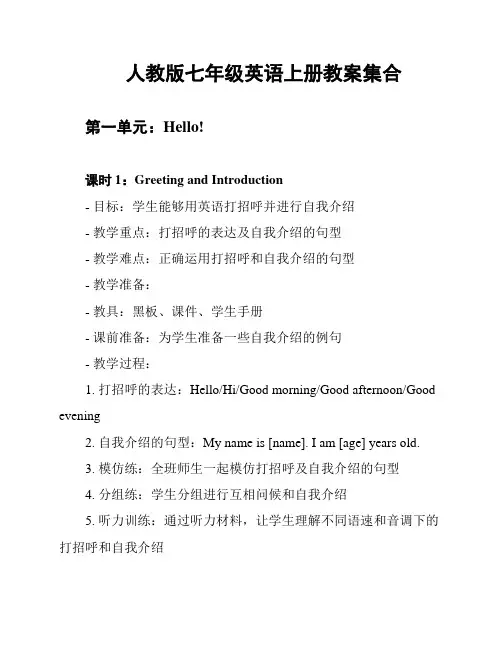
人教版七年级英语上册教案集合第一单元:Hello!课时1:Greeting and Introduction- 目标:学生能够用英语打招呼并进行自我介绍- 教学重点:打招呼的表达及自我介绍的句型- 教学难点:正确运用打招呼和自我介绍的句型- 教学准备:- 教具:黑板、课件、学生手册- 课前准备:为学生准备一些自我介绍的例句- 教学过程:1. 打招呼的表达:Hello/Hi/Good morning/Good afternoon/Good evening2. 自我介绍的句型:My name is [name]. I am [age] years old.3. 模仿练:全班师生一起模仿打招呼及自我介绍的句型4. 分组练:学生分组进行互相问候和自我介绍5. 听力训练:通过听力材料,让学生理解不同语速和音调下的打招呼和自我介绍6. 情景对话:让学生自己编写并表演打招呼和自我介绍的情景对话- 板书设计:- 打招呼的表达:- Hello!- Hi!- Good morning!- Good afternoon!- Good evening!- 自我介绍的句型:- My name is [name].- I am [age] years old.- 课堂小结:通过本节课的研究,学生掌握了用英语打招呼及进行自我介绍的基本句型,并通过各种练提高了语言表达能力。
课时2:Numbers and Colors- 目标:学生能够准确使用英语表达数字和颜色- 教学重点:基础数字的听写和颜色的辨认及应用- 教学难点:数字的听词辨音和颜色的运用- 教学准备:- 教具:黑板、课件、学生手册、彩色笔- 课前准备:为学生准备一些颜色图片和数字卡片- 教学过程:1. 数字的听写:教师用黑板或课件呈现数字,让学生尽量听出并写下数字2. 数字的读写:学生互相组合数字卡片,进行数字的读写练3. 颜色的辨认与运用:教师用彩色笔在黑板上画不同的颜色,让学生说出对应的颜色4. 颜色小游戏:教师出示一些颜色图片,让学生用英语说出对应的颜色5. 数字和颜色的综合运用:教师设计一些综合练,让学生在语境中运用数字和颜色进行口语表达- 板书设计:- 数字的读写:- 0-10: zero, one, two, three, four, five, six, seven, eight, nine, ten - 颜色的辨认与运用:- red, blue, yellow, green, orange, purple, pink, black, white- 课堂小结:通过本节课的研究,学生掌握了基础数字的听写和读写,以及颜色的辨认与运用。
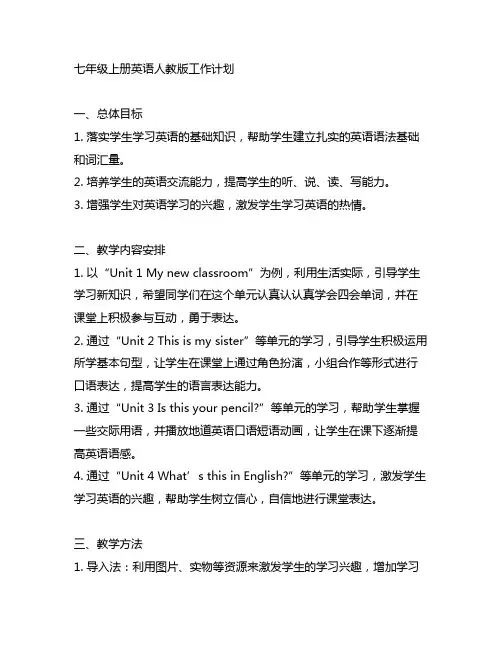
七年级上册英语人教版工作计划一、总体目标1. 落实学生学习英语的基础知识,帮助学生建立扎实的英语语法基础和词汇量。
2. 培养学生的英语交流能力,提高学生的听、说、读、写能力。
3. 增强学生对英语学习的兴趣,激发学生学习英语的热情。
二、教学内容安排1. 以“Unit 1 My new classroom”为例,利用生活实际,引导学生学习新知识,希望同学们在这个单元认真认认真学会四会单词,并在课堂上积极参与互动,勇于表达。
2. 通过“Unit 2 This is my sister”等单元的学习,引导学生积极运用所学基本句型,让学生在课堂上通过角色扮演,小组合作等形式进行口语表达,提高学生的语言表达能力。
3. 通过“Unit 3 Is this your pencil?”等单元的学习,帮助学生掌握一些交际用语,并播放地道英语口语短语动画,让学生在课下逐渐提高英语语感。
4. 通过“Unit 4 What’s this in English?”等单元的学习,激发学生学习英语的兴趣,帮助学生树立信心,自信地进行课堂表达。
三、教学方法1. 导入法:利用图片、实物等资源来激发学生的学习兴趣,增加学习效果。
2. 任务型教学法:通过小组合作、角色扮演等形式,让学生亲身实践,提高学生的语言表达能力。
3. 归纳总结法:引导学生在课下对所学知识进行总结,通过课堂检测来检验学生的学习情况,巩固所学知识。
四、教学手段1. 多媒体教学:利用投影仪、电脑等多媒体设备展示课件或英语教学视频,增加学生的学习趣味性。
2. 实物教学:利用课件和实物进行学习展示,让学生更加直观地了解英语知识。
3. 课外阅读:组织学生进行阅读英语短篇小说或故事,增强学生对英语的理解与应用能力。
五、教学评价1. 针对性评价:对学生的英语听、说、读、写能力进行多角度、多层次的评价,及时发现问题。
2. 及时反馈:针对学生的学习情况,定期进行成绩反馈和学习建议,帮助学生及时调整学习方法。
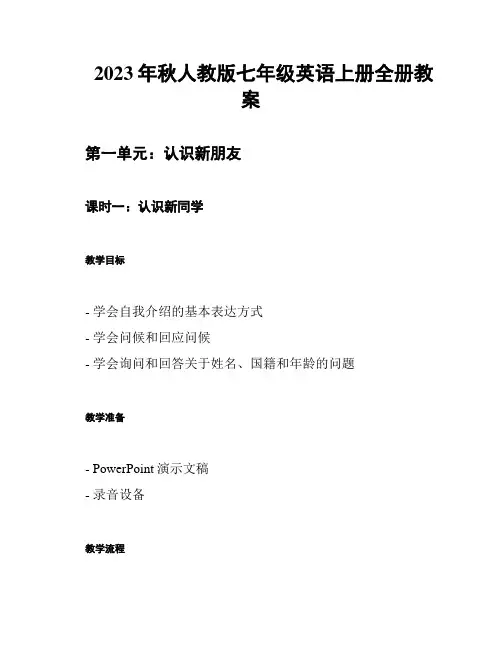
2023年秋人教版七年级英语上册全册教案第一单元:认识新朋友课时一:认识新同学教学目标- 学会自我介绍的基本表达方式- 学会问候和回应问候- 学会询问和回答关于姓名、国籍和年龄的问题教学准备- PowerPoint演示文稿- 录音设备教学流程1. 热身活动:师生互动问候,学生之间自我介绍2. 向学生展示自我介绍的范文3. 播放录音,让学生模仿录音中的自我介绍4. 组织学生进行小组活动,互相询问姓名、国籍和年龄,并进行回答5. 教师在互动活动中进行评价和纠正,引导学生使用正确的表达方式教学扩展- 角色扮演:学生们分成小组进行角色扮演,练自我介绍和互相问候- 家庭作业:要求学生写一篇关于自己的自我介绍,包括姓名、国籍和年龄课时二:我的学校教学目标- 学会用简单的形容词描述学校的特点- 学会询问和回答关于学校的问题- 学会运用句型"What's this/that?"和"It's a/an..."教学准备- PowerPoint演示文稿- 实物或图片展示学校的不同场景和物品教学流程1. 热身活动:回顾上节课所学的自我介绍,学生之间互相询问姓名、国籍和年龄2. 展示学校的图片和实物,引导学生用"What's this/that?"和"It's a/an..."的句型来询问和回答3. 教师介绍形容词,并让学生用形容词描述学校的不同场景和物品4. 组织学生进行小组活动,让他们互相描述自己所在学校的特点5. 教师在互动活动中进行评价和纠正,引导学生使用正确的句型和词汇教学扩展- 画画比赛:学生们用画画的方式描述自己喜欢的学校场景,并进行展示和比较- 家庭作业:要求学生写一篇关于自己学校的简短介绍,并包括一些形容词描述---以上是第一单元的教案内容,详细的教学步骤和教学资源可以根据实际情况进行调整和补充。
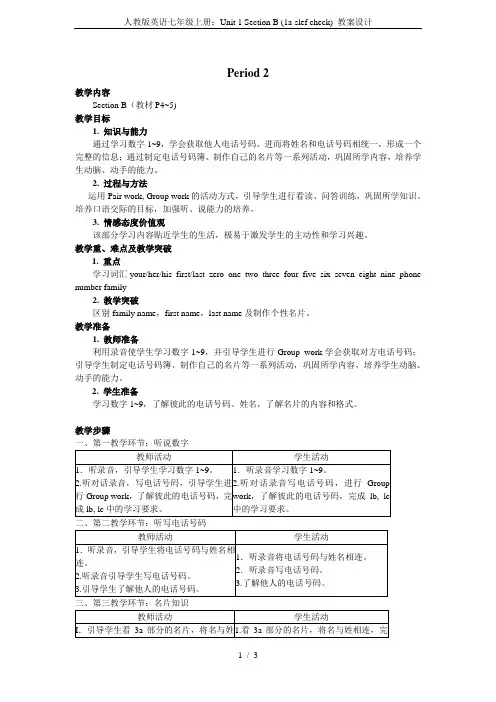
Period 2教学内容Section B(教材P4~5)教学目标1. 知识与能力通过学习数字1~9,学会获取他人电话号码。
进而将姓名和电话号码相统一,形成一个完整的信息;通过制定电话号码簿、制作自己的名片等一系列活动,巩固所学内容,培养学生动脑、动手的能力。
2. 过程与方法运用Pair work, Group work的活动方式,引导学生进行看读、问答训练,巩固所学知识。
培养口语交际的目标,加强听、说能力的培养。
3. 情感态度价值观该部分学习内容贴近学生的生活,极易于激发学生的主动性和学习兴趣。
教学重、难点及教学突破1. 重点学习词汇your/her/his first/last zero one two three four five six seven eight nine phone number family2. 教学突破区别family name,first name,last name及制作个性名片。
教学准备1. 教师准备利用录音使学生学习数字1~9,并引导学生进行Group work学会获取对方电话号码;引导学生制定电话号码簿、制作自己的名片等一系列活动,巩固所学内容,培养学生动脑、动手的能力。
2. 学生准备学习数字1~9,了解彼此的电话号码、姓名,了解名片的内容和格式。
教学步骤一、第一教学环节:听说数字三、第三教学环节:名片知识通过学习数字1~9,使学生学会获取他人电话号码。
通过区别Family name, First name, Last name及了解名片的内容和格式。
通过制作电话号码薄、制作自己的名片等一系列活动,巩固所学内容,培养学生动脑、动手的能力。
板书设计Unit 1 Section BWords: your/her/his first/last zero one two three four five six seven eight nine phone number familyDrills:What’s your phone number? It’s 281-9176.What's your/her/his family /first/ last name?ID card:FIRST NAME:______________LAST NAME:______________TELEPHONR NUMBER:______________________个性练习设计制作个人名片在班级相互交流。
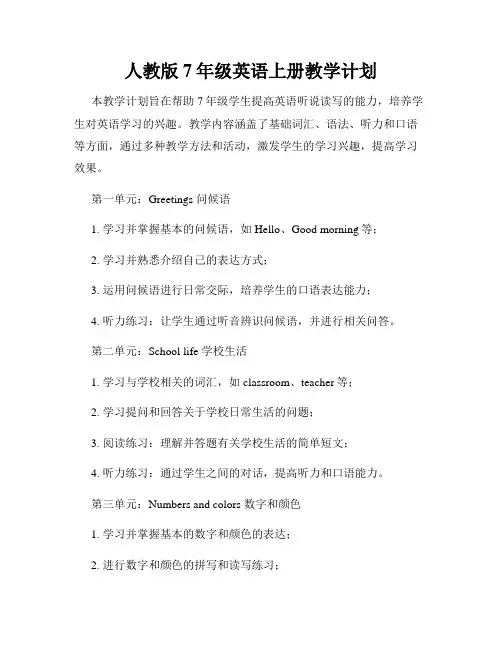
人教版7年级英语上册教学计划本教学计划旨在帮助7年级学生提高英语听说读写的能力,培养学生对英语学习的兴趣。
教学内容涵盖了基础词汇、语法、听力和口语等方面,通过多种教学方法和活动,激发学生的学习兴趣,提高学习效果。
第一单元:Greetings 问候语1. 学习并掌握基本的问候语,如Hello、Good morning等;2. 学习并熟悉介绍自己的表达方式;3. 运用问候语进行日常交际,培养学生的口语表达能力;4. 听力练习:让学生通过听音辨识问候语,并进行相关问答。
第二单元:School life 学校生活1. 学习与学校相关的词汇,如classroom、teacher等;2. 学习提问和回答关于学校日常生活的问题;3. 阅读练习:理解并答题有关学校生活的简单短文;4. 听力练习:通过学生之间的对话,提高听力和口语能力。
第三单元:Numbers and colors 数字和颜色1. 学习并掌握基本的数字和颜色的表达;2. 进行数字和颜色的拼写和读写练习;3. 学习如何问询年龄以及回答;4. 拓展练习:通过游戏和练习巩固学过的内容。
第四单元:Family and friends 家人和朋友1. 学习并熟悉家庭成员的词汇,如father、mother等;2. 运用所学词汇介绍自己的家人和朋友;3. 听力练习:通过听对话理解他人家庭的组成;4. 阅读练习:阅读短文,回答与家庭和朋友相关的问题。
第五单元:Daily routines 日常作息1. 学习常见的日常活动词汇,如get up、go to bed等;2. 进行日常活动的模拟对话练习;3. 听力训练:听力理解并填写他人的日常活动表格;4. 写作练习:写一篇关于自己日常作息的小短文。
第六单元:School subjects 学科1. 学习并掌握常见的学科词汇,如math、science等;2. 学习如何问询自己的学科和常见学科的表达;3. 听力练习:听对话,理解他人的学习情况;4. 阅读练习:读一篇有关学科的短文,并回答相关问题。
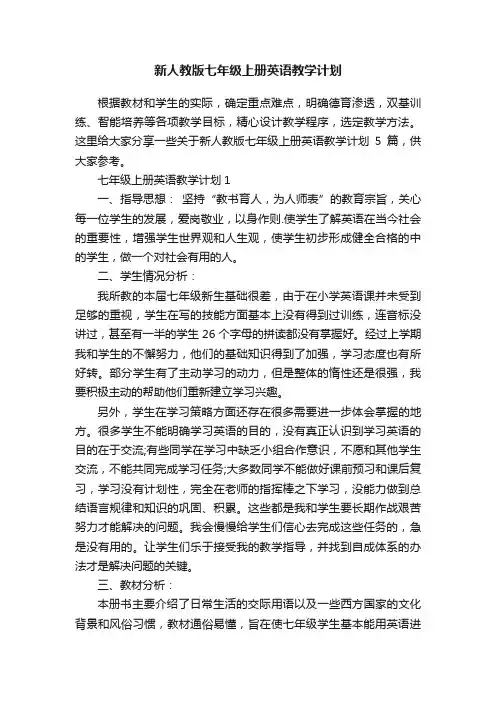
新人教版七年级上册英语教学计划根据教材和学生的实际,确定重点难点,明确德育渗透,双基训练、智能培养等各项教学目标,精心设计教学程序,选定教学方法。
这里给大家分享一些关于新人教版七年级上册英语教学计划5篇,供大家参考。
七年级上册英语教学计划1一、指导思想:坚持“教书育人,为人师表”的教育宗旨,关心每一位学生的发展,爱岗敬业,以身作则.使学生了解英语在当今社会的重要性,增强学生世界观和人生观,使学生初步形成健全合格的中的学生,做一个对社会有用的人。
二、学生情况分析:我所教的本届七年级新生基础很差,由于在小学英语课并未受到足够的重视,学生在写的技能方面基本上没有得到过训练,连音标没讲过,甚至有一半的学生26个字母的拼读都没有掌握好。
经过上学期我和学生的不懈努力,他们的基础知识得到了加强,学习态度也有所好转。
部分学生有了主动学习的动力,但是整体的惰性还是很强,我要积极主动的帮助他们重新建立学习兴趣。
另外,学生在学习策略方面还存在很多需要进一步体会掌握的地方。
很多学生不能明确学习英语的目的,没有真正认识到学习英语的目的在于交流;有些同学在学习中缺乏小组合作意识,不愿和其他学生交流,不能共同完成学习任务;大多数同学不能做好课前预习和课后复习,学习没有计划性,完全在老师的指挥棒之下学习,没能力做到总结语言规律和知识的巩固、积累。
这些都是我和学生要长期作战艰苦努力才能解决的问题。
我会慢慢给学生们信心去完成这些任务的,急是没有用的。
让学生们乐于接受我的教学指导,并找到自成体系的办法才是解决问题的关键。
三、教材分析:本册书主要介绍了日常生活的交际用语以及一些西方国家的文化背景和风俗习惯,教材通俗易懂,旨在使七年级学生基本能用英语进行简单的交流。
本册书由两部分组成,即预备篇(3个单元)和正式篇(9个单元)。
本书除提供语言材料外,还配有大量插图和原声录音磁带。
四、教学目标:通过努力,力求每一位学生能开口讲英语,能用英语进行简单的会话。
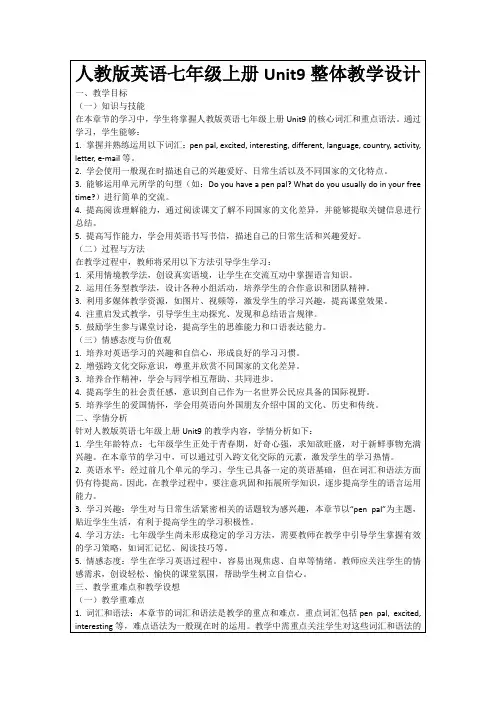
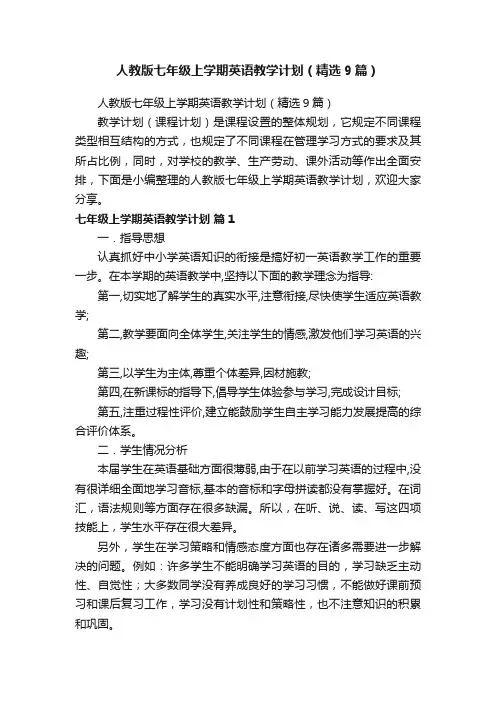
人教版七年级上学期英语教学计划(精选9篇)人教版七年级上学期英语教学计划(精选9篇)教学计划(课程计划)是课程设置的整体规划,它规定不同课程类型相互结构的方式,也规定了不同课程在管理学习方式的要求及其所占比例,同时,对学校的教学、生产劳动、课外活动等作出全面安排,下面是小编整理的人教版七年级上学期英语教学计划,欢迎大家分享。
七年级上学期英语教学计划篇1一.指导思想认真抓好中小学英语知识的衔接是搞好初一英语教学工作的重要一步。
在本学期的英语教学中,坚持以下面的教学理念为指导: 第一,切实地了解学生的真实水平,注意衔接,尽快使学生适应英语教学;第二,教学要面向全体学生,关注学生的情感,激发他们学习英语的兴趣;第三,以学生为主体,尊重个体差异,因材施教;第四,在新课标的指导下,倡导学生体验参与学习,完成设计目标;第五,注重过程性评价,建立能鼓励学生自主学习能力发展提高的综合评价体系。
二.学生情况分析本届学生在英语基础方面很薄弱,由于在以前学习英语的过程中,没有很详细全面地学习音标,基本的音标和字母拼读都没有掌握好。
在词汇,语法规则等方面存在很多缺漏。
所以,在听、说、读、写这四项技能上,学生水平存在很大差异。
另外,学生在学习策略和情感态度方面也存在诸多需要进一步解决的问题。
例如:许多学生不能明确学习英语的目的,学习缺乏主动性、自觉性;大多数同学没有养成良好的学习习惯,不能做好课前预习和课后复习工作,学习没有计划性和策略性,也不注意知识的积累和巩固。
最后,在课堂上,习惯像以往被动地接受所传授的知识,不善于发现和总结语言规律,学习的主体性不突出。
三.教材分析教材特点与重难点:以话题为引导呈现整个单元的内容,词汇量非常大,单元间的梯度较大,是否能适应并完成词汇的学习是学习的重点。
四.教学目标1、总体目标:激发学生学习英语的兴趣,树立自信心。
2、具体目标:使大多数学生能够掌握英语拼读,学生掌握拼读规则后,学习英语词汇自然会变得轻松愉快,记忆单词的效率随着学习的深入将会有质的飞跃。
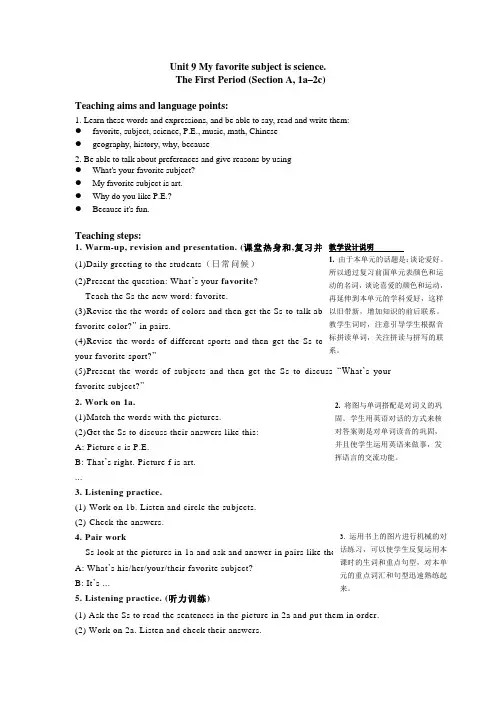
Unit 9 My favorite subject is science. The First Period (Section A, 1a –2c)Teaching aims and language points:1. Learn these words and expressions, and be able to say, read and write them: ● favorite, subject, science, P.E., music, math, Chinese ● geography, history, why, because2. Be able to talk about preferences and give reasons by using ● What's your favorite subject? ● My favorite subject is art. ● Why do you like P.E.? ● Because it's fun.Teaching steps:1. Warm-up, revision and presentation. (课堂热身和,(1)Daily greeting to the students (日常问候) (2)Present the question: What ’s your favorite ?Teach the Ss the new word: favorite. favorite color?” in pairs. (4)Revise the words of different sports and then get the Ss your favorite sport?” (5)Present the words of subjects and then get the Ss to discuss “W hat ’s yourfavorite subject?” 2. Work on 1a.(1)Match the words with the pictures.(2)Get the Ss to discuss their answers like this: A: Picture c is P.E.B: That ’s right. Picture f is art. ...3. Listening practice.(1) Work on 1b. Listen and circle the subjects. (2) Check the answers. 4. Pair workA: What ’s his/her/your/their favorite subject? B: It ’s ...5. Listening practice. (听力训练)(1) Ask the Ss to read the sentences in the picture in 2a and put them in order. (2) Work on 2a. Listen and check their answers.(3) Work on 2b. Listen and match the subjects with the descriptions. (4) Ask the Ss to report their answers like “P.E. is fun .” (5) Explain: Why do you like P.E.? Because it ’s fun. 6. Group work. (小组活动) Interview your group member (1) Make a chart.(2) Ss ask and answer like the conversation in 2c. A: What's your favorite subject? B: Science.A: Why do you like science? B: Because it's interesting.(3) Fill in the chart while talking.7. Homework (家庭作业)1. Remember the new words we learnt today.2. Write a report of your interview.eg. Liu Ming's favorite subject is science. He likes it because it is interesting. ...Unit 9 My favorite subject is science. The Second Period (Section A, 2d –3c)Teaching aims and language points:1. Learn these words and expressions, and be able to say, read and write them: ● Sunday, Monday, Tuesday, Wednesday, Thursday, Friday, Saturday, for sure2. Be able to talk about subjects, schedules and teachers by using ● --How's your day? ● --It's OK.● I like Monday because I have P.E. and history. ● --When do you have P.E.?● --We have P.E. on Monday and Friday. ● --Who's your P.E. teacher? ● --Mr. Hu.● I think history is interesting.That's for sure.Teaching steps:1. Warm-up and revision (课堂热身和复习)4. 进行小组调查就是为了给学生一个语言交际的理由,使学生运用本课时的单词和句型进行有意义有目的的对话。
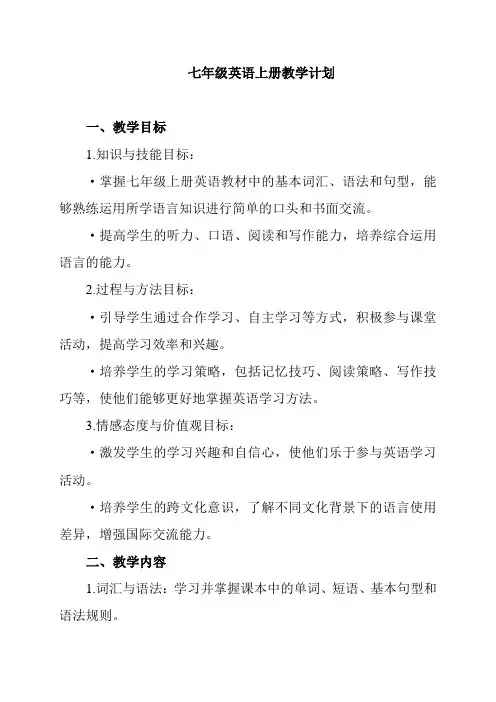
七年级英语上册教学计划一、教学目标1.知识与技能目标:·掌握七年级上册英语教材中的基本词汇、语法和句型,能够熟练运用所学语言知识进行简单的口头和书面交流。
·提高学生的听力、口语、阅读和写作能力,培养综合运用语言的能力。
2.过程与方法目标:·引导学生通过合作学习、自主学习等方式,积极参与课堂活动,提高学习效率和兴趣。
·培养学生的学习策略,包括记忆技巧、阅读策略、写作技巧等,使他们能够更好地掌握英语学习方法。
3.情感态度与价值观目标:·激发学生的学习兴趣和自信心,使他们乐于参与英语学习活动。
·培养学生的跨文化意识,了解不同文化背景下的语言使用差异,增强国际交流能力。
二、教学内容1.词汇与语法:学习并掌握课本中的单词、短语、基本句型和语法规则。
2.听说训练:通过对话、角色扮演、听力练习等方式,提高学生的口语表达能力和听力理解能力。
3.阅读理解:通过阅读课文和简单的英语文章,培养学生的阅读能力和阅读速度,提高阅读理解能力。
4.写作技能:通过写作练习,培养学生的写作技巧,包括写作结构、语法运用、词汇选择等。
三、教学方法与策略1.情境教学法:创设真实或模拟的语言环境,让学生在情境中学习和运用英语,提高语言的实际运用能力。
2.互动式教学:通过小组讨论、角色扮演、游戏等方式,鼓励学生积极参与课堂活动,提高学习的主动性和合作性。
3.多媒体教学:利用多媒体教学工具,如PPT、视频、音频等,使教学内容更加生动直观,激发学生的学习兴趣。
四、评价与反馈1.课堂表现评价:关注学生的课堂参与度、发言质量、合作能力等方面,及时给予鼓励和引导。
2.作业与测试评价:对学生的作业进行认真批改,指出优点和不足,提出改进建议;定期进行测试和考试,了解学生的学习情况,为教学提供反馈。
五、教学进度安排根据学校的教学安排和教材特点,合理制定教学进度表,确保按时完成教学任务。
同时,根据学生的学习情况和反馈,灵活调整教学进度和教学内容。
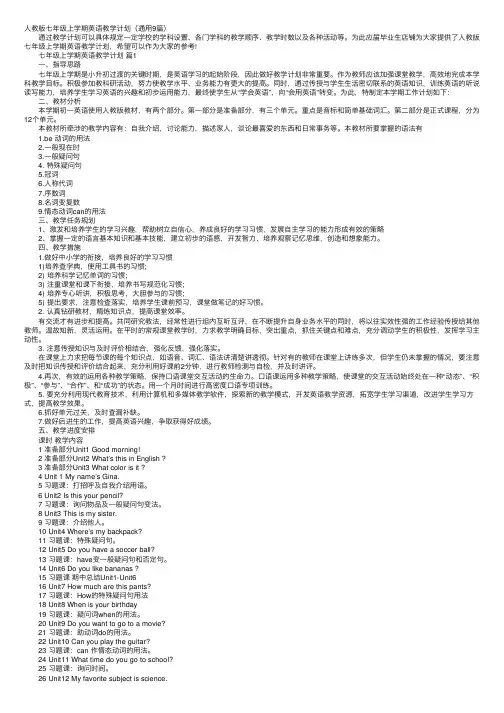
⼈教版七年级上学期英语教学计划(通⽤9篇) 通过教学计划可以具体规定⼀定学校的学科设置、各门学科的教学顺序、教学时数以及各种活动等。
为此应届毕业⽣店铺为⼤家提供了⼈教版七年级上学期英语教学计划,希望可以作为⼤家的参考! 七年级上学期英语教学计划篇1 ⼀、指导思路 七年级上学期是⼩升初过渡的关键时期,是英语学习的起始阶段,因此做好教学计划⾮常重要。
作为教师应该加强课堂教学,⾼效地完成本学科教学⽬标。
积极参加教科研活动,努⼒使教学⽔平、业务能⼒有更⼤的提⾼。
同时,通过传授与学⽣⽣活密切联系的英语知识,训练英语的听说读写能⼒,培养学⽣学习英语的兴趣和初步运⽤能⼒,最终使学⽣从“学会英语”,向“会⽤英语”转变。
为此,特制定本学期⼯作计划如下: ⼆、教材分析 本学期初⼀英语使⽤⼈教版教材,有两个部分。
第⼀部分是准备部分,有三个单元。
重点是⾳标和简单基础词汇。
第⼆部分是正式课程,分为12个单元。
本教材所牵涉的教学内容有:⾃我介绍,讨论能⼒,描述家⼈,谈论最喜爱的东西和⽇常事务等。
本教材所要掌握的语法有 1.be 动词的⽤法 2.⼀般现在时 3.⼀般疑问句 4. 特殊疑问句 5.冠词 6.⼈称代词 7.序数词 8.名词变复数 9.情态动词can的⽤法 三、教学任务规划 1、激发和培养学⽣的学习兴趣,帮助树⽴⾃信⼼,养成良好的学习习惯,发展⾃主学习的能⼒形成有效的策略 2、掌握⼀定的语⾔基本知识和基本技能,建⽴初步的语感,开发智⼒、培养观察记忆思维,创造和想象能⼒。
四、教学措施 1.做好中⼩学的衔接,培养良好的学习习惯 1)培养查字典,使⽤⼯具书的习惯; 2) 培养科学记忆单词的习惯; 3) 注重课堂和课下衔接,培养书写规范化习惯; 4) 培养专⼼听讲,积极思考,⼤胆参与的习惯; 5) 提出要求,注意检查落实,培养学⽣课前预习,课堂做笔记的好习惯。
2. 认真钻研教材,精炼知识点,提⾼课堂效率。
有交流才有进步和提⾼。
Unit9 My favorite subject is science.授课班级授课类型教学目标教学内容重点难点学情分析授课日期新授课学时数The 1st period (Section A 1a — 1c)1.Learn to talk about somebody ’s favorite subjects and give reasons.2.Revise some adjectives.New words: subject, P.E., science, history, biology,because--- What ’s your favorite subject? --- My favoritesubject is ⋯---Why do you like ⋯?---Because it ’s⋯---What ’s your favorite subject?--- My favorite subject is⋯---Why do you like ⋯?---Because it ’s⋯教学方法学习方法课题引入教学步骤及主要内容任务型教学、分级评价法、直观教学法、模仿示范法、情景教学和合作学习法课前预习、课堂内外练习、听说读写结合教学过程设计备注I. Warming-up and revisionT: How are you today?S:We are fine. (show a picture of Chinese teacher)T:Who is this woman/man?S:She/he is Miss/ Mr. ⋯ . She/He is our Chinese teacher.T:Do you have a Chinese lesson today?S:Yes,⋯ ./No, ⋯ .T:Do you have a math lesson today?S:Yes, ⋯ ./No,⋯T:Who is your math teacher?S:⋯.II.PresentationT:Chinese and math are subjects. what other subjects do we have today? Do we have math/art/ music/ PE/science/ history/ biology lesson today?S:⋯T:What subjects do we have this year?S:We have math/English/Chinese ⋯ .T:What subjects do we have in middle school?S: We have math/English/Chinese ⋯.Focus attention on the word list and the example: Say: Number 1 is C,tennis racket. Match the words and picture. check the answers.III.Work on 1aT:Look at the pictures on P71. Please match the words with the pictures.S:Picture c is a P.E class. Picture d is an art class. Picture b is a scienceclass.Picture e is a music class. Picture a is a math class. Picture f is aChinese class.IV . Work on 1bT: Let ’s listen to the tape and circle the subjects in 1a you hear.S: Now let ’s check the answers. The boy ’s favorite subject is science. And the girl likes art and math, but her favorite subject is music.V.Listen and repeat.T: Listen to the tape and repeat.VI. Work on 1cT:The boy’s favorite subject is science. And the girl ’s favorite subject is music.What about you? What ’s your favorite subject?S:My favorite subject is ⋯T:What’s Tom’s favorite subject? Ask him, please.S: What’s your favorite subject, Tom?Now talk about your favorite subject.VII. Presentation1. S1: What’s your favorite subject?S2: My ⋯ .S1: Why do you like ⋯ ?S2: Because⋯.2 T: Is ⋯ your favorite subject?S: No, ⋯ .课堂练习T: Why don ’tyou like ⋯ ?S: Because it’s difficult/ boring⋯ .VIII. Work on 2c, 2dT: I think English is interesting. What do you think?S: ⋯.T: what about other subjects?Look at your books, match the subjects with the description words.T / S: What do you think of these subjects?S: I think art is interesting.T / S: So is it your favorite subject?S: Yes, you’re right.T / S: What do you think of science?S: ⋯ .IX. Work on 2aT:Look at the four sentences in the picture. Now listen and put theconversation in order.Answer:From left to right: 4-1-2-3X. Work on 2bT:The girl likes P.E., because it is fun. How about the other subjects? Nowlisten again and match the subjects with the description words you hear.T:What ’s the girl ’s/ boy’s favorite subject? Why does she / he like it?S:Her / His favorite subject is P.E. / music, because it is fun / relaxing.T:Now let ’s listen to the tape and repeat. Please try to read like the tape.Tapescript:A:What ’s your favorite subject?B:My favorite subject is P.E.A:Why do you like P.E.?B:Because it ’s fun. How about you? What ’s your favorite subject.A:Hmm. My favorite subject is music.B:Really? Why?A:Because it ’s relaxing.XII. Group workS1: What’s your favorite subject?S2: My favorite subject is⋯S1: Why do you like⋯?S2: Because⋯ . What about you?S1: ⋯.(S3 and S4 make a similar conversation in turns 〕S1: What’s S4’s favorite subject?S3: His/ Her ⋯ .S1: Why does he/she⋯ .S3: Because⋯小结与作业课堂小结XIII. Homework1.Listen and read after the tape for thirty minutes.本课作业2.Recite the first converstaion of Section A, 2c.3.Write down the Chinese meaning of the new words and key sentences,then translate them into English.Unit9 My favorite subject is science.授课班级授课类型教学目标教学内容重点难点学情分析授课日期对话课学时数The 2nd period (Section A,3a –Section B, 2b)1. Learn to talk about ss ’favorite subjects and give reasons.2. Learn to talk about ss ’favorite things and give reasons.New words: city, mom ,dad---What ’s your favorite ⋯ (subject, color, city ⋯ )?---My favorite ⋯ is ⋯---Why do you like ⋯ ?---Because it ’s⋯---Who is your ⋯ teacher⋯?---Mr / Miss ⋯---What ’s your favorite ⋯ (subject, color, city ⋯ )?---My favorite ⋯ is ⋯---Why do you like ⋯ ?---Because it ’s⋯---Who is your ⋯ teacher⋯?---Mr / Miss ⋯教学方法学习方法课题引入任务型教学、分级评价法、直观教学法、模仿示范法、情景教学和合作学习法课前预习、课堂内外练习、听说读写结合教学过程设计备注I. Warming- up and revisionDaily greeting and revision.T:How are you today?S:I am fine.T:How many subjects do you have today?S:Seven.T:What are they?S:They are Chinese/math/English . ⋯T:What ’s your favorite subject?S:My favorite subject is ⋯ .T:Why do you like it?S:Because it’s ⋯ .II. PresentationT:What ’s your favorite subject?S:My favorite subject is (math)?T:Why do you like (math)?S:Because it is (interesting).T:I ’m your English teacher. Who is your math teacher?S:Mr/ Mrs/ Miss ⋯ is my math teacher.T:Ask your friend about his /her favorite subject and teacher, please.S1: What’s your favorite subject?S2: My ⋯ .S1: Who ’s your ⋯ teacher?S2: Mr/ Mrs/ Miss ⋯ is my math teacher./ My ⋯ teacher is ⋯ .S1: What’s S3’s favorite subject?S2: ⋯S3:⋯III. Grammar focusT: I think games are interesting. Let’s play a guessing game.A come hereand have a look at a note in the box. Then ask others questions: What’sMary ’s favorite subject? Why does she like it? Others try to find the answer byguessing like this: Is ⋯ her favorite subject? Is her favoritesubject ⋯? ⋯教学步骤A: What ’s Mary 〞s favorite subject?及S1: Is Chinese her favorite subject?主要内容A: No, it isn ’t.S2: Is English her favorite subject?A: No, it isn ’t.⋯S:Is math her favorite subject?A:Yes, it is. Why does she like it?S:Because it is relaxing?A: No, it isn ’t.⋯S:Because it is interesting?A:Yes, it is.IV . Work on 3aT:How about this girl? Now complete the conversation. You can use the words in the box. Then tell me something about the girl.S1: What is your favorite subject?S2: My favorite subject is art.S1: Who is your art teacher?S2: My art teacher is Mrs Jones.T: Now tell me something about the girl. What’s her favorite subject and whois the teacher?S: The girl ’s favorite subject is art. Her art teacher is Mrs Jones.V . Work on 3bT:How about your partner? Do you know want to know about your classmates?Now ask your classmates about his/her questions and complete the chart,then give a report.Name:FavoriteReasoteacherDescription ofsubjectn teacherI:S1:S2:Report:My name is __________.My favorite subject is __________because it is ________.My ________ teacher is _________.I like her/him very much.She/He is really ___________.______ ’s favorite subject is___________.VI . PairworkT:I know your favorite subject is ⋯ . But what ’s your favorite city? Is Linhai / Hangzhou / Shanghai ⋯ your favorite city?S: My favorite city is⋯S1: ⋯S2: ⋯⋯T: Now I ’d like you to talk about your favorite things in pairs.VII . SurveyT: Now we know a lot about our classmates. But do you knowanything about your mom and dad? Complete the chart with their favorite课堂练习things. Then talk about them with your classmates.FavoriteFavoriteFavorite Favoritecityfoodcolor TV showMomDadS1: What’s your mother ’s favorite city?S2: Her favorite city is⋯Report like this: S: ___ ’s mom’s favorite city is ... Her favorite food is⋯Butther/his dad’s favorite is ⋯小结与作业课堂小结VIII. Homework1.Listen and read after the tape for thirty minutes.本课作业2. Recite the second converstaion of Section A, 2c.3.Write down the Chinese meaning of the new words and key sentences,then translate them into English.本课教学后记〔课堂设计理念,实际教学效果及改良设想〕Unit9 M y favorite subject is science.授课班级授课类型教学目标教学内容重点难点学情分析教学方法学习方法课题引入授课日期稳固课学时数The 3rd period (Section B 1a –2c)1.Learn to talk about ss’favorite subjects and give reasons.2.Learn the seven days of the week.New words: Sunday,Monday,Tuesday, Wednesday, Thursday, Friday, Saturday ---When do you have (math)?---On Monday.---When does he/she have ⋯ ?---On ⋯---When do you have (math)?---On Monday.---When does he/she have ⋯ ?---On ⋯任务型教学、分级评价法、直观教学法、模仿示范法、情景教学和合作学习法课前预习、课堂内外练习、听说读写结合教学过程设计备注I. Warming-up and revision1. One-minute talk. Topic: My Favorite⋯(e.g. I have many subjects at school, they are ⋯ My favorite subject is⋯. I likeit because it is ⋯ And ⋯ is my ⋯ He/She is ⋯ I like him/her very much, too.My favorite city is⋯, because it is⋯.)2. After the talk get the students ask and answer questions about it.教学步骤及主要内容课堂练习II. Presentation 1.Dailygreeting andrevisionT:⋯ (name)just saysyou havemanysubjects atschool. T:Whatclasses doyou have today?S:We have English/Chinese,/science .⋯T: Oh, so many classes today. What day is it today?T: What ’s the date today?thS:It ’s (January 7 ).T:Today is (January 7 th). But what day is it today?S: It ’s (Friday).thT:Then what day is January 8 ?S:January 8th is Saturday.⋯2. T: There are seven days in a week. But which day is the first day of the week?Is it Monday?S: No, it ’s Sunday.T: Good! The first day of the week is⋯S:The first day of the week is Sunday. The second day of the week is Monday.The third day of the week is Tuesday. The fourth day of the week isWednesday. The fifth day of the week is Thursday. The sixth day of the week is Friday. The seventh day of the week is Saturday.T:Let ’s say the days of the week quickly, clapping our hands.T: Now let ’s sing the song: Days of the week.III.Work on 1aT:Now look at 1a. These days are out of order. Please put them in order by numberin the boxes 1 –7.S1: No. 1.September 30.S2: Sunday.S3: No. 2.October 1.S4: Monday.S5: No. 3.October 2.S6: Tuesday.S7: No. 4.October 3.S8: Wednesday.S9: No. 5.October 4.S10: Thursday.S11: No. 6. October 5.S12: Friday.S13: No. 7. October 6.S14: Saturday.IV . Work on 1bT:Quite good. There are seven days in a week. And we come to school five daysa week. In these five days we have to study at school. But what subjects dowe study? Now check the subjects in 1b quickly.T:What subjects do you study at school?S:We have art, science, music, math, P.E. and Chinese. But we don’t havehistory or biology now.V. Work on 1cT:When (What time) do you have art?Do you have art on Monday?S: Yes, we have art on Monday morning. / No, we have art on Tuesdayafternoon.T: When do we have English?S:We have English on Monday, Tuesday ⋯ ./We have it every day.T:OK. Look at the chart ask and answer about the time of subjects in pairs.VI . Work on 2aT:We have different subjects on different days. What about Ming, Selinaand Ken?What subjects do they study? Please listen to the tape and write down theschool subjects they talk about in the tape.T:What subjects do they talk about?S:Biology, history, art and science.VII . Work on 2bT:What subjects do Ming, Selina and Ken like? When do they have these subjects?Listen again and fill in the chart of 2b.VIII . Work on 2cT:Now we know something about Ming, Selina and Ken. Please make aconversation about them. You can use the information from the chart. You maymake up dialogues like 2c on P74. (What ’s ⋯ favorite ⋯ ? Why⋯ ? When⋯?)小结与作业课堂小结IX. HomeworkMake a survey:T:Now it ’s your turn to make up your own dialogues. Please work with yourgroup (four students in one group) and finish this chart.A:Hi/Hey, ⋯ What subject doesn’t⋯ like?B:He/She doesn’tlike ⋯A:Why doesn ’the/she like ⋯B:Because ⋯A:When does he/she have ⋯B:On ⋯本课作业⋯SubjectWhy? When?FavoriteName Why? When?doesn’tlike subjectS1S2S3Report:In my group, there are _________ ________ and _________._________ doesn’tlike _________, because _____________.He/She has __________ on ___________. But his/her favoritesubject is __________. _________________________________________________________________________________________________________________________________________X. Homework1.Listen and read after the tape for thirty minutes.2.Recite the second conversation of Section B, 1b.3.Write down the Chinese meaning of the new words and sentences,translate them into English.本课教学后记〔课堂设计理念,实际教学效果及改良设想〕。
人教版初一英语上册教案精选15篇教案可以帮助教师明确教学的目标和要求,指导教师在课堂上进行教学活动。
下面是小编为大家整理的人教版初一英语上册教案,如果大家喜欢可以分享给身边的朋友。
人教版初一英语上册教案【篇1】一、指导思想虽然大部分学生在小学已接触过英语,但学生以前不大重视英语,造成英语两极分化严重,且学习积极性低。
所以,现阶段最重要的是激发学生学习英语的兴趣和积极性,帮助他们增强信心,克服困难。
除了从思想上给予引导之外,在教学上,有针对性、目的性、有系统、有计划地上好课。
二、班级基本情况:本学期我担任七年级的英语课。
绝大多数学生虽然小学阶段都学过英语,但大部分学生的英语基础都比较差。
缺少学习的主动性和热情,自觉性也较差,相应的学习习惯也较差,对学习英语有为难情绪。
针对这些情况,在本学期的英语教学中,本人将致力于:一方面,应加强英语基础知识的讲解和基本技能的训练,让学生掌握词汇、语法、句型的基础知识和听、说、读、写等基本技能,为进一步学习英语打下坚实的基础;另一方面,又要采取多种措施,注意培养学生对英语学习的兴趣;让学生掌握记忆语音、单词、阅读和写作等英语学习技巧,培养良好的学习习惯和自主探索、合作探究能力,充分调动学生的学习积极性和主动性。
教学上采取任务型教学方式,运用灵活多变的方法,实现学生语言运用能力的迁移和拓展。
尊重并理解学生,与学生一起分享学习中的苦与乐,使每一位学生的英语成绩有所提高,有所进步。
三、七年级上册英语教学重、难点:(一)、语法知识点.1.一般疑问句及回答;2.指示代词、人称代词、物主代词3.名词复数的变化;4.方位介词;5.特殊疑问句的构成、回答和对划线部分提问6.实义动词的第三人称单数及变化;7、名词所有格;8、一般现在时9、时间表达法;(二)、交际用语。
四、七年级上册英语教学措施初一年级是英语学习的基础阶段,也是养成好习惯的关键时期。
基础打不好、习惯不良,直接影响学生整个初中阶段,乃至高中、大学的英语学习。
七年级英语上册教学工作计划《七年级英语上册教学工作计划》一、教学目标:1. 能够掌握日常生活用语,进行简单日常对话和交流。
2. 能够正确地运用一般现在时和一般过去时进行语言表达。
3. 能够理解和运用七年级上册英语教材中的基本语法知识和词汇。
4. 培养学生的听说读写能力,提高他们的英语综合运用能力。
二、教学内容:1. 单元主题:介绍自己、家人和朋友;描述日常活动和生活环境;谈论学校生活和课余生活。
2. 语言技能:听、说、读、写的培养和训练。
3. 语言知识:基本的语法知识和常用词汇的学习。
三、教学重点和难点:1. 重点:学生的听、说、读、写能力的培养。
2. 难点:一般现在时和一般过去时的运用。
四、教学方法:1. 任务型教学法:通过任务驱动学生的学习和运用英语。
2. 情景教学法:用具体的语境和情景来帮助学生理解和运用语言。
3. 合作学习法:培养学生的团队合作精神和交流能力。
五、教学手段:1. 多媒体设备:通过图片、音频和视频设备展示直观生动的英语语言情景和知识点。
2. 教学用具:包括英语教材、练习册、教学挂图等教学辅助用具。
3. 网络资源:利用网络资源辅助教学,拓展学生的英语学习渠道。
六、教学过程:1. 创设真实的语言情景,培养学生的兴趣和学习动力。
2. 运用多种教学方法,让学生通过听、说、读、写全方面地掌握语言技能。
3. 注重巩固和延伸,让学生在课上掌握了的知识和技能能够在课外得到应用。
七、教学评价:1. 定期进行测试,及时发现学生的学习情况,并采取相应的教学措施。
2. 鼓励学生参加各类英语角活动,提高他们的英语运用水平。
八、教学总结:1. 不断总结教学经验,提高教学质量和效果。
2. 关注学生学习兴趣和需求,使教学更加贴近学生的生活和实际应用。
Unit9 单元知识点精讲【学习目标】1.熟悉who,why等特殊疑问句的一般现在时,并用其谈论学习生活中的常见活动,掌握本单元的描绘事物性质的形容词。
2.复习时间的表示法。
学习星期的名称。
熟练拼读星期一至星期日的所有单词。
【重点难点】1.一般现在时的特殊疑问句(1)对主语提问用“疑问词+谓语+其他”句型。
如:Who is your good friend?谁是你的好朋友?Who helps you clean the house?谁帮你打扫房间?(2)对定语提问用“疑问词+被修饰的词+一般疑问句”句型。
如:What classes does he often go to?他经常去上什么课?What time do you often have sports?你什么时候进行体育活动?(3)对其他成分提问用“疑问词+一般疑问句”句型。
如:Where does your uncle work?你叔叔在哪儿工作?When do you get up every day?你每天什么时候起床?2.英语中表示时间的介词归纳如下:(1)in表示在某年、某月、某个季节及没有具体说明的哪一天的上午、下午、晚上。
如:in 2002,in May,in spring,in the morning等。
(2)on用于表示“在”具体的某日,或某日上午,下午,晚上。
如:on Monday 在星期一on Sunday afternoon 在星期日下午on May 1 在五月一号(3)at用于表示在某一时刻。
如:at seven o'clock 在7点整;at 6∶30 in the morning 在早上6∶30(4)某些介词用在固定的短语中。
如:at weekends,on weekdays,at this time of day,at noon,at night,in the day等。
3.表示星期的名词共有七个表示星期的词:Monday,Tuesday,Wednesday,Thursday,Friday,Saturday,Sunday;提问方式:What day is it today?或What day is today?其中it指时间,today是副词,作状语。
人教版初中英语七年级上册教案【】人教版初中英语七年级上册教案【完整版】教案一:Unit 1 My School Day课时目标通过本课的研究,学生将能够:- 熟悉并正确运用词汇:morning, afternoon, class, library, schoolbag, pencil case;- 学会表达日常活动并能使用句子:I haveEnglish/Math/Chinese/Art class in the morning/afternoon;- 规范使用句型:What do you have in the morning/afternoon? I have...- 了解不同国家的学校日常活动;- 培养学生自主研究和合作研究的能力。
教学重难点- 重点:掌握词汇和句型的正确运用,以及学校日常活动的表达方式;- 难点:个别学生可能难以理解不同国家的学校日常活动。
教学准备课件、图片、黑板、笔记本、学生课本等。
教学过程1. 导入新课:- 利用图片和问题引入话题,激发学生的兴趣。
- 向学生展示不同国家的学校图片,询问学生对这些学校的日常活动有什么了解。
2. 研究新词汇和句型:- 通过图片和示范,教授新词汇和句型。
- 学生跟读并模仿教师正确运用句型进行练。
3. 合作研究:- 将学生分成小组,让他们利用所学的句型进行交流和讨论。
- 教师巡视并指导学生在小组中开展合作研究。
4. 归纳总结:- 教师与学生一起归纳总结本课所学的内容,以加深记忆。
- 学生用自己的话表达今天的收获。
5. 作业布置:- 布置家庭作业,要求学生用英语描述自己在早上和下午的学校日常活动。
教学反思本节课通过情境导入和多种教学方法的使用,激发了学生学习英语的兴趣。
合作学习环节有效地培养了学生的社交能力和语言表达能力。
通过图片和示范引导学生学习新词汇和句型,使学生能够运用所学知识进行交流和描述,达到了教学目标。
—学年人教版新目标七年级英语教学计划教学计划如下:
课程:七年级英语
教材:人教版新目标七年级英语教材
教学目标:
1. 熟练掌握基本的英语词汇和语法知识。
2. 提高听、说、读、写的能力,能够进行简单的英语交流。
3. 培养学生的英语学习兴趣,激发学生学习英语的热情。
4. 培养学生的独立学习能力和团队合作精神。
教学内容:
1. 各单元的词汇和语法知识。
2. 各单元的听力、口语、阅读、写作练习。
3. 英语学习方法和技巧的培养。
教学活动安排:
1. 每周安排几次课堂教学,结合听力练习、口语练习、阅读理解和写作练习。
2. 鼓励学生参加课外活动,如英语角、英语竞赛等,提高英语交流能力。
3. 定期组织单元测试,检验学生的学习情况,及时调整教学计划。
教学评价:
1. 考核方式包括平时表现、作业完成情况、单元测试成绩等综合考量。
2. 学生的学习态度、参与度和成绩表现均为评价的重要指标。
以上为七年级英语教学计划,希望能够对您有所帮助。